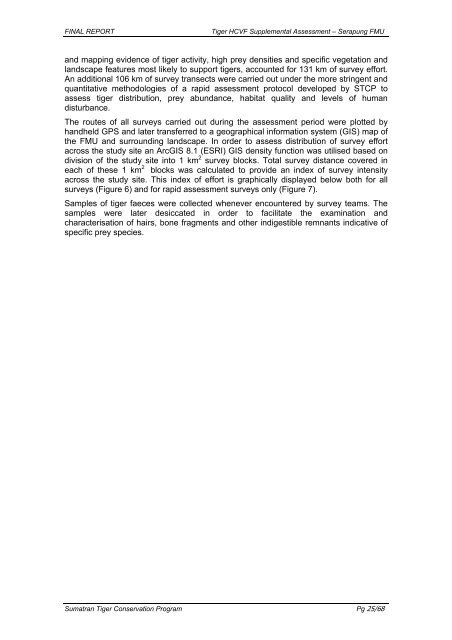A Supplemental HCVF Assessment on the Sumatran Tiger ...
A Supplemental HCVF Assessment on the Sumatran Tiger ...
A Supplemental HCVF Assessment on the Sumatran Tiger ...
Create successful ePaper yourself
Turn your PDF publications into a flip-book with our unique Google optimized e-Paper software.
FINAL REPORT <strong>Tiger</strong> <str<strong>on</strong>g>HCVF</str<strong>on</strong>g> <str<strong>on</strong>g>Supplemental</str<strong>on</strong>g> <str<strong>on</strong>g>Assessment</str<strong>on</strong>g> – Serapung FMU<br />
and mapping evidence of tiger activity, high prey densities and specific vegetati<strong>on</strong> and<br />
landscape features most likely to support tigers, accounted for 131 km of survey effort.<br />
An additi<strong>on</strong>al 106 km of survey transects were carried out under <strong>the</strong> more stringent and<br />
quantitative methodologies of a rapid assessment protocol developed by STCP to<br />
assess tiger distributi<strong>on</strong>, prey abundance, habitat quality and levels of human<br />
disturbance.<br />
The routes of all surveys carried out during <strong>the</strong> assessment period were plotted by<br />
handheld GPS and later transferred to a geographical informati<strong>on</strong> system (GIS) map of<br />
<strong>the</strong> FMU and surrounding landscape. In order to assess distributi<strong>on</strong> of survey effort<br />
across <strong>the</strong> study site an ArcGIS 8.1 (ESRI) GIS density functi<strong>on</strong> was utilised based <strong>on</strong><br />
divisi<strong>on</strong> of <strong>the</strong> study site into 1 km 2 survey blocks. Total survey distance covered in<br />
each of <strong>the</strong>se 1 km 2 blocks was calculated to provide an index of survey intensity<br />
across <strong>the</strong> study site. This index of effort is graphically displayed below both for all<br />
surveys (Figure 6) and for rapid assessment surveys <strong>on</strong>ly (Figure 7).<br />
Samples of tiger faeces were collected whenever encountered by survey teams. The<br />
samples were later desiccated in order to facilitate <strong>the</strong> examinati<strong>on</strong> and<br />
characterisati<strong>on</strong> of hairs, b<strong>on</strong>e fragments and o<strong>the</strong>r indigestible remnants indicative of<br />
specific prey species.<br />
<strong>Sumatran</strong> <strong>Tiger</strong> C<strong>on</strong>servati<strong>on</strong> Program Pg 25/68

















